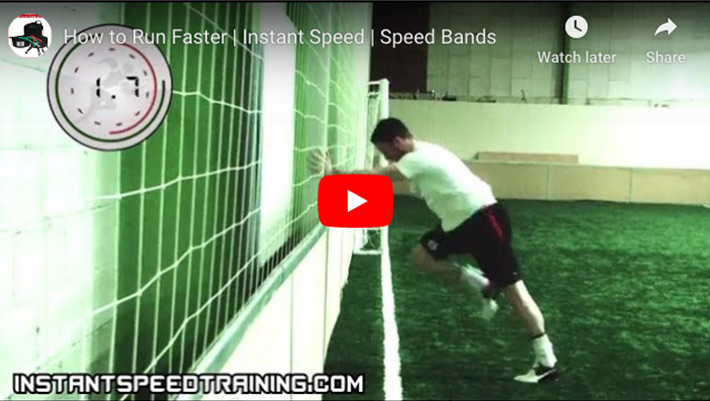
Athletes of all sports must always continue to work on improving their speed. Sprint speed is broken down into two elements – stride length and stride frequency. If you want to run faster, you must work on improving the two.
Resisted Wall Sprints
- 10 seconds with resistance (3-4 sets).
- 12 seconds without resistance (2 sets).
Resisted Sprints (Sprints with some sort of resistance – Speed Bands to slow you down) have been proven to increase speed because when you take them off you benefit of the contrast effect when your legs feel feather light and so you can move more explosively. These sprints build lower-body power by activating the fast twitch muscle fibres in the hamstrings, quad and glute muscles.
Wall drills essentially are sprinting in the acceleration phase against a wall. Place your hands at shoulder height against a wall. Step back until your body is at a 45 degree angle. Plant your feet hip-width apart. Your heels do not have to be flat on the floor. With the Speed Bands attached start sprinting at maximum effort. It’s a challenging drill that can give great results.
The unresisted sets are the most important part of the exercise. When you take the bands off, your legs will feel light and strong giving you the ability to sprint at a faster pace. This is the optimal time for muscle recruitment so perform the unresisted sets at 100% effort in order to improve your speed.
The Power Line
These Wall Drills allow you to “sprint” without actually running, which helps you get used to the feel of the “power line” position, where your head, shoulders, hips, knees and ankles all form a line that’s angled about 45 degrees from the ground. This position is the ideal form to propel yourself forward and allow your muscles to exert maximum power.
Mountain Climbers Exercise
- 3-4 Resisted sets of 10 seconds.
- 2 Un-resisted sets of 12 seconds
Because of its ability to work multiple muscle groups, the mountain climber exercise is associated with multiple benefits.
Benefits of Resisted Mountain Climbers
1. Power Training
Mountain climbers with Speed Bands help you develop power in the lower body (hip-flexors, glutes, quads and hamstrings) because of their explosive nature and this is why many athletes frequently use them as a warm-up to help improve speed. As you perform mountain climbers over time, you will experience an increase in the explosiveness of your lower body. Try to remain on the balls of your feet and switch leg positions as fast as you can.
Mountain Climbers for speed training should be a part of every athlete’s program.
2. Core Strength
When doing mountain climbers your torso won’t sag towards the floor because of the work done by your obliques, abdominals and the muscles around your hips as they isometrically contract, holding your core stable. If you want to really challenge these muscles, try placing your hands on top of a medicine ball that is by your chest’s centre.
3. Cardiovascular Benefits
Doing mountain climbers will make your body work to provide the tissues which are working with fuel and oxygen and because of this they will increase both your breathing and heart rate. The stress involved in this exercise helps develop the cardiovascular system by strengthening the heart and lungs in addition to burning calories. This is a great option to incorporate in a circuit workout, especially between strength training exercises which are less intense as they will help you keep your heart rate in the right zone.











